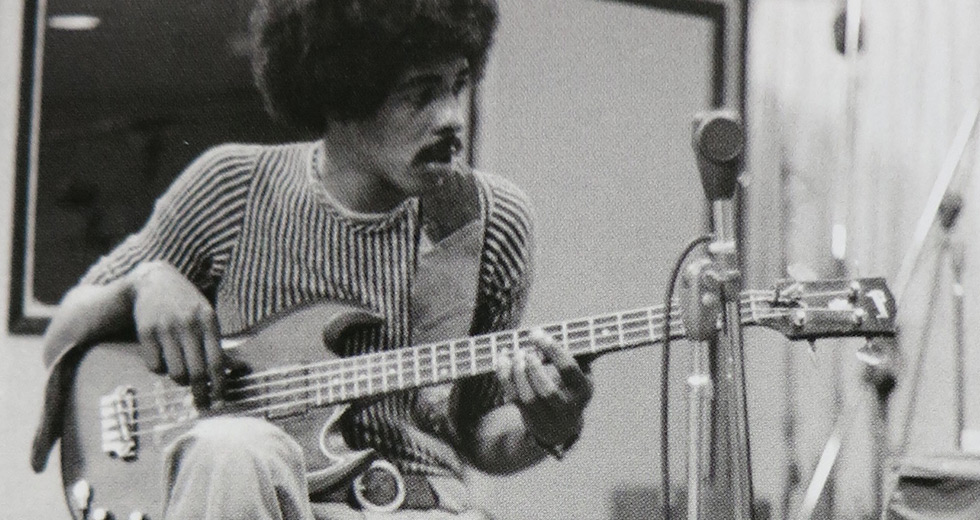Decoder: Einstürzende Neubauten, Genesis P-Orridge and Sonic Terrorism
The first years of Neue Deutsche Welle deserve to be remembered as some of the most creative in German music history. The scene eventually became commercialized, but many of the originators didn’t buy in
Einstürzende Neubauten was among this group of artists. Their uncompromising music throughout the early ’80s won them many admirers, though – both home and abroad. In this excerpt taken from Berlin Sampler, Theo Lessour explains the group’s acting and musical contribution to the film Decoder. A cult classic of sci-fi dystopia, Decoder saw Neubauten’s members working alongside Genesis P-Orridge and William S. Burroughs. It’s one of the strangest (and most prescient) films of the decade.
When Einstürzende Neubauten’s Blixa Bargeld was once asked to comment on Neue Deutsche Welle, he explained that pop music was all about manipulation, in a similar way to politics. The deviancy of pop music is a manipulative deviancy whose ultimate goal is to liberate the masses, to aid the emergence of minorities that stand against the dictatorship of the majority. Pop musicians “played” at politics in the same way they played music. The film Decoder aimed to decode the techniques of manipulation to get at the real information beneath; a poetic joke intended to unscramble the codes of manipulation so that they could be re-appropriated to subvert their originators.
The general idea is that insurrectionists should place loudspeakers in the streets to simulate riot sounds and conjure up imaginary disturbances.
The film was made in Hamburg and Berlin, and directed by Muscha (who directed several punk films). The lead roles are played by Christiane F and FM Einheit from Einstürzende Neubauten, who also contributed to the film’s score. Genesis P-Orridge (from Psychic TV), the kingpin of the English industrial scene, also appears as a priest of the Black Noise faith. Author William S. Burroughs portrays an insurrectionist salesman of audio equipment, and American cult actor Bill Rice plays a detective. Matt Johnson from The The wrote a frenetic, deformed song for the film that is both fantastic and painful to listen to: “Three Orange Kisses from Kazan.” But Dave Ball and Genesis P-Orridge composed the rest of the soundtrack. (Dave Ball was the other half of Marc Almond’s Soft Cell, at the time one of the biggest groups in the English underground electro-pop scene.)
Decoder is split into three parts, each one filmed through a heavily saturated primary colour filter of red, green or blue. (The first decoding is of the power of colours.) It’s a futuristic film, a joyous application of William S. Burroughs’ The Electronic Revolution, which proposes a seditious and rather poetic method of subverting the masses and inciting them to rise up against the forces of order. The general idea is that insurrectionists should place loudspeakers in the streets to simulate riot sounds and conjure up imaginary disturbances, fostering a permanent sense of insecurity and terrorizing the enemy. It’s all intended to create an atmosphere that would cause actual riots. Appropriately, Burroughs himself was given the role of the audio equipment salesman who is secretly fomenting revolution from inside his dusty little shop.
The “hero” is played by FM Einheit, who one day realizes that the food served in the city’s fast food joints and the muzak being piped into them are two sides of the same coin – a massive program intended to control the masses. A priest from the secretive and sect-like Black Noise order then instructs him on the rudiments of manipulation. Together they attack capitalism by using anti-muzak and sonic terrorism. They cause riots and general hysteria by distributing their cassettes to the people. Once the ground has been made fertile for revolution, the masses are then subverted using “the black noise.”
The film may have denounced muzak – seen as a symbol of consumerism’s stranglehold on the world – but its soundtrack actively flirts with it. Dave Ball and Genesis P-Orridge shrewdly hijack elevator music for their own ends: alongside loops taken from actual muzak records are synths that pump out slow, almost funky grooves, a few jazzy spirals of piano notes intertwined with bleeps, samples, grinding sounds, reverb and whispers that could be either sensual or menacing. Decoder rejoices in its dialectic between “muzak” and “black noise” in various ways, looking to take as many liberties and make as many exaggerations as it can get away with.
Once they got there they saw many of the local anarchist protesters were already practicing sonic terrorism in the real world.
The film marked an alliance between the factual, “down to earth” music of German bands like Einstürzende Neubauten and the kind of English industrial music that was considered “magical.” (Bands like Psychic TV, Coil and Current 93 were working on returning an element of ritual to music, seeking to give it back its original religious form and meaning... transforming it into a medium that could induce a ritualized trance state which would then be re-implanted back into materialist consumerist society. Genesis P-Orridge doesn’t play a priest for nothing.) William S. Burroughs would pass the baton between the two in his own wry manner.
Klaus Maeck, who produced and wrote the film, told Vogue in 1984 that he had planned to take advantage of a local protest to a state visit by Ronald Reagan. They had originally wanted to shoot footage of actors using cassette players to create chaos in the crowds. But once they got there they saw that events had overtaken them, as many of the local anarchist protesters were already practicing sonic terrorism in the real world, playing sounds of gunfire, helicopters and explosions into the crowd: “They put tape recorders in windows, and if you’re in the street and you hear all these noises and you don’t know where it’s coming from and you think where is that fucking helicopter? Where is that shooting coming from? People got confused and more and more angry. It actually worked. They even busted tape recorders. They confiscated 200 tape recorders. It was really funny.”
Einstürzende Neubauten returned the favor (or inversed the paradigm) by recording the Berlin May Day demonstrations of 1987, which took place against the backdrop of a particularly fraught anti-census campaign by the left. In Kreuzberg, riots lasted for over 12 hours and police were prevented from getting into the neighborhood. It was a quasi-civil war, with dozens of shops firebombed.
These days... May Day riots take place annually under the watchful eye of a massive police presence.
It was also the last stand of the anarchist punks; the last and perhaps only time that the outsiders thought they could win the battle. “The day that the German State’s monopoly on violence was put up for discussion,” as Biba Kopf laconically put it. These days this struggle with the forces of order has become a kind of politico-folkloric tradition in Kreuzberg, as May Day riots take place annually under the watchful eye of a massive police presence.
The Neubauten’s recordings of the riots were included in “Maifestspiele” on their album Haus der Lüge. It’s impossible to know if the song contains any sonic ricochets of actual “black noise” recordings intended to destabilize the population, but one can always dream...

